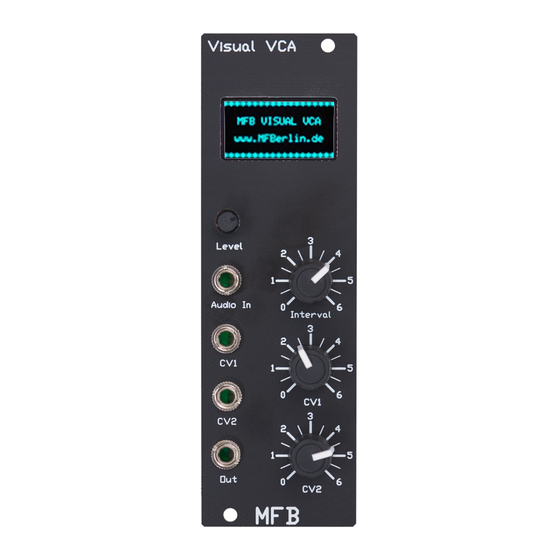
Advertisement
Quick Links
General
The Visual VCA (Voltage Controlled Amplifier) module combines a classic amplifier which
allows manual control over audio signals or by control voltages with an added oscilloscope to
visualize the incoming audio signals such as VCO waveforms.
The VCA uses a logarithmic characteristic which is preferential for audio signals. A
distinctive feature of this VCA is the dependence of both CV-inputs which enable to realize
patches which would typically require two conventional VCAs. The amplifier uses a low-noise
V2162-chip.
Operation
The Visual VCA module is compatible to Doepfer's A-100 modular system in design, bus-
power-supply and CV/gate-voltages. The 10-pin connector-cable has to be connected to the
16-pin bus-circuit-board. The required supply voltage is 12 volts. A separate voltage of 5 volts
is not needed.
The device's power consumption is approximately ±20 mA. The module's width measures 8
HP.
ATTENTION: Please carefully pay attention to correct polarity! The colored lead of the
ribbon cable must point downwards, i.e.: The cable must not be twisted.
Oscilloscope
After switching on the system, the MFB-startup-screen will be displayed, given that no audio
signal is being applied to input VCA In. As soon as an audio signal is being applied here, the
display automatically switches to a graphical visualization.
The amplitude of the signal being displayed depends on the setting of the Level control.
HINT: The quality of the visualization depends on the input signal. Optimal results will be
reached with stable audio signals such as waveforms directly from a VCO. Signals having
passed through a filter or wave shaper can also be displayed in good quality, so that sound
edits can be followed visually.
The more disharmonious a signal, the less clear it can be visualized. Examples would be
sounds with strong modulation components such as weird frequency or ring modulations.
Interval
By using the Interval encoder, the frequency of the graphical display can be adapted to the
input signal in order to achieve a better visualization.
The Interval encoder's push-function switches through the three operating modes: Positive
Sync - Negative Sync - No Sync. This setting defines the view of the waveform from its left
side, starting from the zero-passing. For example, the visualization of a triangle wave will start
with a rising slope when set to positive sync. It will be displayed with a descending slope
when set to negative sync.
By pressing the Interval encoder for approx. one second, the display will switch to a "screen-
saver".
PS: The game can unfortunately not be played.
VCA
Input VCA In serves to feeds an audio-signal into the VCA. Use the Level control to adjust
the corresponding level. The signal should be displayed as a pure curve. Limits at the upper or
lower border of the visualization point to possible clippings.
CV1 / CV2
The signal amplification can be controlled using the two CV-inputs. CV1 will typically be
used in combination with an envelope being triggered by a gate-signal from a keyboard or
sequencer.
Input CV2 can only be used in dependence of input CV1. In explanation: Any control of an
audio-signal by CV2 will only be carried out if a voltage is present at CV1.
A useful application is the volume control by an envelope generator at input CV1 and an LFO
being connected to input CV2. The resulting tremolo being generated by the LFO will only be
active with the note being held. Also, a sound shaping audio modulation (AM, resembling a
ring modulation) is possible using this setup.
Another application for CV2 is the implementation of velocity. Here, the course of the VCA
as defined by an envelope generator is controlled in level by another control voltage which is
being generated by a MIDI/CV-converter using velocity values.
Both CV-inputs offer a corresponding attenuator to limit the modulation depths. These
attenuators accept control voltages ranging from 0 to 5 volts.
Out
The output jack Out carries the audio signal, depending on the control by CV1 and CV2.
From here, the signal can be connected to other modules, a mixer or an audio-interface.
Advertisement

Summary of Contents for MFB Visual VCA
- Page 1 Input CV2 can only be used in dependence of input CV1. In explanation: Any control of an The Visual VCA module is compatible to Doepfer’s A-100 modular system in design, bus- audio-signal by CV2 will only be carried out if a voltage is present at CV1.
- Page 2 Operating Manual Visual VCA module...






Need help?
Do you have a question about the Visual VCA and is the answer not in the manual?
Questions and answers